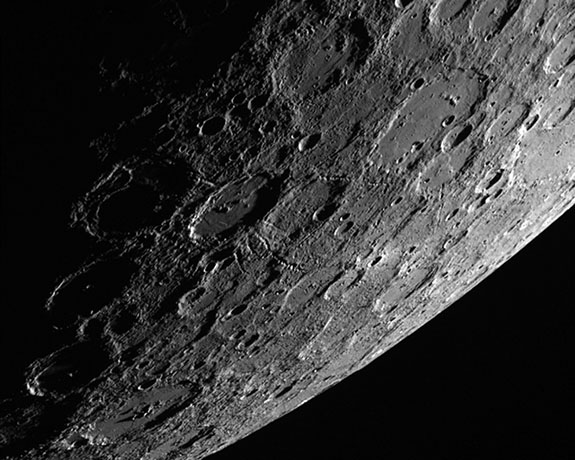Chinese Researchers: Mercury's Surface Could Be Littered With Impact Diamonds
The surface of Mercury, the tiniest planet in the solar system and the one that orbits closest to the Sun, could be littered with an untold wealth of diamonds, according to researchers at Sun Yat-sen University in Zhuhai, China.

NASA’s Messenger was the first spacecraft to orbit the planet back in 2011. It took nearly seven years for the probe to complete the 224-million-mile trip, and one of the important takeaways from the four-year mission was that Mercury's dark grey surface contained a lot of graphite, the same carbon-based material that's in your #2 pencil.
But, in a study published last week in the journal Nature Astronomy, the Chinese scientists argued that there's a strong probability that the Mercury also contains diamonds, which form when the carbon molecules are subjected to immense heat and pressure.
“If the primary crust of Mercury was made of graphite, we can imagine that the continuous evolution in 4.56 billion years — with countless impact events, mixing and destruction — would have seen most of the early graphite undergo phase changes and become other forms, including diamond,” lead author Xiao Zhiyong, a professor with Sun Yat-sen University’s school of atmospheric sciences, told the South China Morning Post.
The Chinese scientists' conclusions align neatly with the theories of Kevin Cannon, a planetary scientist and assistant professor at the Colorado School of Mines, who spoke about the likelihood of Mercury diamonds at the Lunar and Planetary Science Conference in Houston back in March of 2022.
He explained at the time that since Mercury’s composition is high in carbon, when high-speed foreign objects smash into the surface, the perfect recipe of heat, pressure and carbon results in a diamond byproduct.
“The pressure wave from asteroids or comets striking the surface at tens of kilometers per second could transform that graphite into diamonds,” Cannon noted. “You could have a significant amount of diamonds near the surface.”
According to wired.com, Cannon and his team modeled what was likely to happen to Mercury’s crust after being pummeled for billions of year. Cannon theorized that the graphite on the surface of Mercury could be more than 300 feet thick and that the impact pressure from asteroids would have produced enough energy to transform 30% to 60% of that material into “shock diamonds.”
According to Cannon, there could be 16 quadrillion tons of diamonds on the surface of Mercury.
If you're thinking about the possibility of mining some of those riches, the good news is that Mercury is not that far away. In fact, the BepiColombo mission launched in 2018 will finally arrive at that planet in 2025. A joint effort of the European and Japanese space agencies, BepiColombo is equipped with high-resolution cameras that could provide conclusive evidence of diamonds on that planet's surface.
The bad news about the idea of Mercury-based space mining is that its inhospitable daytime temperatures can reach 800 degrees, higher than the temperature inside a commercial pizza oven.
Credit: Image courtesy of NASA/Johns Hopkins University Applied Physics Laboratory/Carnegie Institution of Washington, Public domain, via Wikimedia Commons.

NASA’s Messenger was the first spacecraft to orbit the planet back in 2011. It took nearly seven years for the probe to complete the 224-million-mile trip, and one of the important takeaways from the four-year mission was that Mercury's dark grey surface contained a lot of graphite, the same carbon-based material that's in your #2 pencil.
But, in a study published last week in the journal Nature Astronomy, the Chinese scientists argued that there's a strong probability that the Mercury also contains diamonds, which form when the carbon molecules are subjected to immense heat and pressure.
“If the primary crust of Mercury was made of graphite, we can imagine that the continuous evolution in 4.56 billion years — with countless impact events, mixing and destruction — would have seen most of the early graphite undergo phase changes and become other forms, including diamond,” lead author Xiao Zhiyong, a professor with Sun Yat-sen University’s school of atmospheric sciences, told the South China Morning Post.
The Chinese scientists' conclusions align neatly with the theories of Kevin Cannon, a planetary scientist and assistant professor at the Colorado School of Mines, who spoke about the likelihood of Mercury diamonds at the Lunar and Planetary Science Conference in Houston back in March of 2022.
He explained at the time that since Mercury’s composition is high in carbon, when high-speed foreign objects smash into the surface, the perfect recipe of heat, pressure and carbon results in a diamond byproduct.
“The pressure wave from asteroids or comets striking the surface at tens of kilometers per second could transform that graphite into diamonds,” Cannon noted. “You could have a significant amount of diamonds near the surface.”
According to wired.com, Cannon and his team modeled what was likely to happen to Mercury’s crust after being pummeled for billions of year. Cannon theorized that the graphite on the surface of Mercury could be more than 300 feet thick and that the impact pressure from asteroids would have produced enough energy to transform 30% to 60% of that material into “shock diamonds.”
According to Cannon, there could be 16 quadrillion tons of diamonds on the surface of Mercury.
If you're thinking about the possibility of mining some of those riches, the good news is that Mercury is not that far away. In fact, the BepiColombo mission launched in 2018 will finally arrive at that planet in 2025. A joint effort of the European and Japanese space agencies, BepiColombo is equipped with high-resolution cameras that could provide conclusive evidence of diamonds on that planet's surface.
The bad news about the idea of Mercury-based space mining is that its inhospitable daytime temperatures can reach 800 degrees, higher than the temperature inside a commercial pizza oven.
Credit: Image courtesy of NASA/Johns Hopkins University Applied Physics Laboratory/Carnegie Institution of Washington, Public domain, via Wikimedia Commons.

